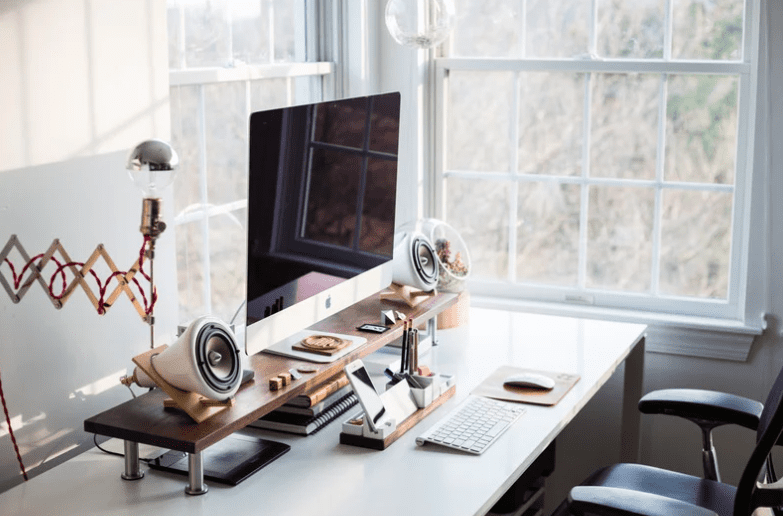As society begins to return to normal post-COVID, many changes have occurred in the workplace setting for a large cross-section of the workforce. Workers in office-based jobs were largely working from home for months at a time during the height of the pandemic. As a result of the progress in online meeting technology and proven efficiency of working from home, many workers and companies are considering the ongoing benefits of working from their home office.
However, with this increased prevalence of working from home, new challenges have also presented themselves to the workforce. One of these challenges is the general setup of the home workspace. Companies have spent a lot of time and money to ensure their offices and worksites are set up with the most beneficial ergonomic equipment to prevent postural pain and injuries from affecting their staff. At home this is generally not the case, with many workers having cramped, ‘pop-up’ work areas with minimal ergonomic considerations, which ultimately leads to musculoskeletal pain. Further health risks include metabolic disease resulting from the decreased movement that comes with people leaving their homes less frequently, and psychosocial health issues from decreased social interactions with colleagues in the work environment.
In this post, we’ll run through several working from home tips and strategies that can be implemented to minimise these risk factors.
How to successfully work from home
There are four key areas that need to be focused on to achieve an optimal working from home outcome. These areas include:
Creating a good routine
Having a workstation that is set up ergonomically
Ensuring to incorporate social interaction
Continuing to schedule and accomplish routine movement and exercise sessions
Each of these working from home tips will be discussed in more detail below.

1. Routine
When working from home, it’s vital that workers are disciplined in their daily habits. It’s easy to take a break, drift towards the kitchen and start snacking on unhealthy foods. To avoid this, a worker should plan out their meals and snacks the day before or over the weekend, just as if they were heading into the office. It’s also important not to get sucked into watching late night, binge TV shows, and thinking it’s ok because they can sleep in and don’t need to travel to work. Ultimately, maintaining a normal sleep routine and getting at least 7-8 hours of sleep a night will mean they can continue to perform optimally while working from home.
Workers should make sure they have a start and finish time to stick to, which should include planned break times throughout the day. It is easy for work and personal time to blur when working from home, and people can find themselves working long into the night when they have a home office setup.
If there are other family members in the house during the workday, it’s important they know the worker’s timetable and understand they cannot interrupt them during this period for gossip or daily chats. If there are young children in the house while working from home, then it may be beneficial to reach out to extended family for assistance on these days.
One of the greatest distractions that exists in the modern household (and may prove to be the greatest disruptor to working from home) is the prevalence of screen-based devices like phones, TVs and computer games. It’s very easy to be distracted by a notification on our phones, which may lead to scrolling through social media or reading news articles. Hours in the day may rapidly disappear when this occurs.
Likewise, if the TV is on or a video game is loaded on the computer that’s used for work, the worker may be tempted or distracted away from their work. Ensure that all non-work devices are switched off and only work-related notifications are enabled while working from home. Most modern devices have nifty notification scheduling settings that can help with this.
A final challenge to the working from home routine is housework and chores. It’s easy to get sidetracked by quickly cleaning the room, mowing the lawn or washing laundry. Although some of these smaller chores may be achievable, these should only be completed during periods of the day that were already planned as breaks from the office.

2. Ergonomic Setup
People working from home should ensure they have a room or isolated space that can be a dedicated work area. This should be in an area with limited visual or environmental distractions, and should not be near the main family living space or windows that overlook busy outside areas. Working from a laptop on a bed or couch will never lead to efficient output, as we inherently recognise these spaces as relaxing or ‘shut-off’ areas. Also, workers are more likely to suffer from multiple postural pain issues as a result of poor ergonomic position.
Setting up the workspace ergonomically is important to avoid the above-mentioned postural pain syndromes that most office-based workplaces have eliminated over time. Here’s a great example of recommendations for an ergonomic setup for working from home. Employ Health offers a range of workstation ergonomics services, including for people working from home. You can learn more about these services here.
It’s also important to have fast enough internet at home to meet the requirements of the job, particularly if it’s likely to include online group meetings.

3. Social Interaction
Everyone that has worked in an office knows it can be disruptive having people constantly stopping at your desk and chatting or saying hello. Humans are tribal animals, and these interactions at lunch or around the proverbial water cooler are very important for our emotional health. So, although not having those constant interactions with people at work may allow for more time spent working, it’s critical that peer interactions can still be facilitated when working from home. This may include organising walks before or after work, coffee catch-ups, and planned time for phone calls or online catch-ups to discuss non-work related matters.
Staying in the loop with work colleagues is an important aspect of still feeling like a team and being part of each other’s lives. So don’t forget those anniversaries and birthday

